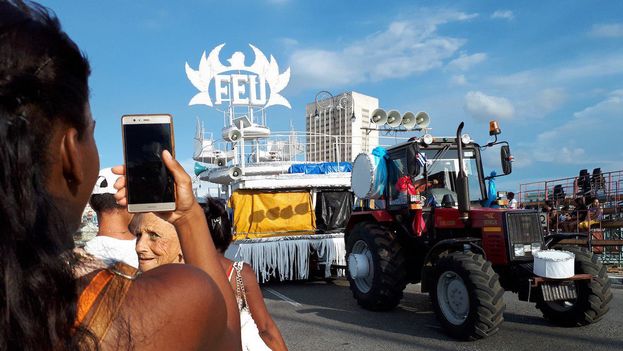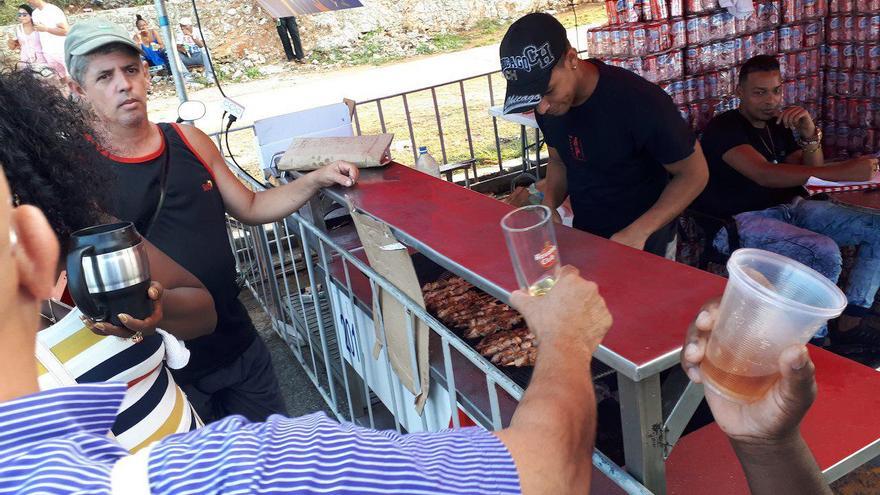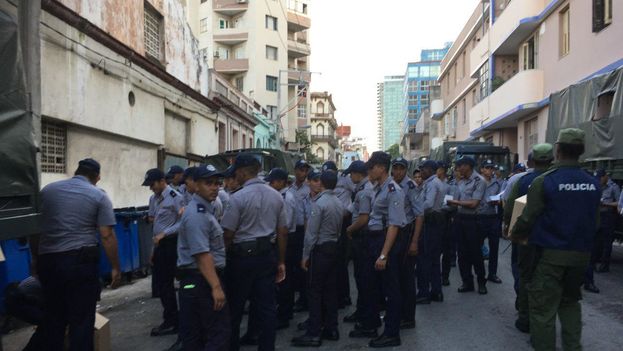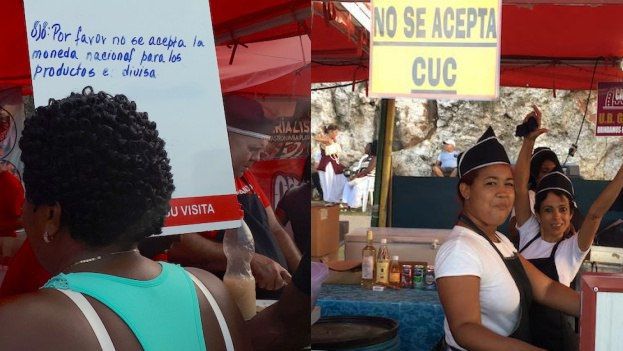
![]() 14ymedio, Zunilda Mata, Havana | August 27, 2018 — The long lines this Sunday announced where beer was being sold at Havana’s carnivals, the most sought-after product for clients of few resources. On its last weekend, Cuba’s dual currency system made itself strongly felt at the most important festival for the people in the Cuban capital.
14ymedio, Zunilda Mata, Havana | August 27, 2018 — The long lines this Sunday announced where beer was being sold at Havana’s carnivals, the most sought-after product for clients of few resources. On its last weekend, Cuba’s dual currency system made itself strongly felt at the most important festival for the people in the Cuban capital.
“National money is not accepted,” read a sign at a kiosk with canned beverages, some imported and others local. The authorities have preferred to keep sales divided based on the currency used (Cuban pesos, also called national money and abbreviated CUP, or Cuban convertible pesos, abbreviated CUC), a decision that created multiple inconveniences.
“It was a decision of the Management of the Carnival and the Provincial Cultural Administration of Havana,” explained an employee of a kiosk named after the neighborhood of Mantilla. “We only do what they tell us and here we can only sell in Cuban pesos.”
“I had to buy fried chicken in one kiosk and beer in another because one was in national money and the other in convertible pesos,” lamented Sandra, a 37-year-old Havana resident who spent years “without stepping foot in the carnival because it isn’t worth it.” This Sunday she decided to venture out even though the event ended up being dangerous.
Brawls are frequent at Havana celebrations, which have gained a reputation for being troubled and risky, despite the strict security and the rules prohibiting the carrying of knives. In recent years the presence of families with children has notably lessened as a consquence of the violence.

The division by currencies is a reminder of the first years of the Dollarization of the Cuban economy in the 90s, when popular celebrations were split between the poor offerings available in CUP and the more varied in dollars or convertible pesos. Over time, however, sales were united and at recent carnivals one could pay without distinction at the exchange of 1 CUC for 24 CUP.
The measure of separate sales between CUC and CUP contrasts with the progressive advance of the acceptance of both currencies in the network of retail stores. “In almost every store you can pay in one currency or the other, but when you come to the carnival it works another way, here no one understands it,” lamented a frustrated customer.
Unlike canned, beer on tap, the cheapest beverage for sale, was sold in Cuban pesos for the price of 9 CUP for a glass. “It’s the only chance to have a beer at this price because the rest of the year they don’t sell it on tap in CUP anywhere,” Sandra points out.

Criticisms were also directed at the little variety in the food for sale. “In all the kiosks it’s the same, roast pork, fried chicken, or roast pork sandwiches,” explains Randy. “If you’re lucky you can find corn on the cob but nothing else, this carnival doesn’t evolve in terms of food, it’s always the same.”
Near Randy, a few foreigners tried to explain to a vendor that they wanted a little hot sauce to put on some skewers of pork cooked over charcoal and stuck on a thin piece of pine wood. “No, we don’t have any sauce, hot sauce or otherwise,” the employee responded sharply.
The lack of places to sit and enjoy the celebrations was also one of the most-criticized points. Only the area of the stands and the boxes had seats. Unlike other years, where cafeterias or food areas with tables were also installed, this time all consumption of drinks and food happened at kiosks and bars.
In the Maceo Park area families had benches, but in other areas participants had to remain standing the whole time. “For a good part of the way there is no access to the Malecón wall because they have put kiosks there or put up bars so that people can’t pass,” a retiree explained to 14ymedio.

Security guards justified the measure as a way of “better controlling the situation in one area,” specified an agent. “It’s not the same to have people on both sides of the street where floats and carnival troupes are parading, than to be able to keep them on one side.”
The unusual scene of a Malecón wall completely empty repeated itself in the area around Calle 23, a very crowded area with various food and drink kiosks.
A few private vendors ventured there with their tidbits especially for children. “There are many controls to stop us from selling in these areas because they say that we are creating competition for the state kiosks,” explained Michel, a vendor of popcorn and toasted peanuts.
A few meters from his sales cart, in an alcove of Avenida Malecón, dozens of police officers prepared to enter the festivities. Around 7:00 PM each received a carboard box with some rice, a piece of pork, and French fries. “Eat quickly because the sun is already setting,” yelled an official.
The uniformed officers rapidly devoured the food and went in groups to the zone of the festivities, where in large lines in front of the kiosks people kept asking if this was a line to pay in CUP or in CUC.
Translated by: Sheilagh Carey
______________________
The 14ymedio team is committed to serious journalism that reflects the reality of deep Cuba. Thank you for joining us on this long road. We invite you to continue supporting us, but this time by becoming a member of 14ymedio. Together we can continue to transform journalism in Cuba.
